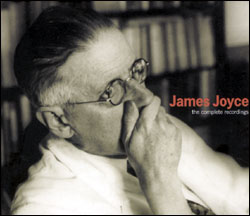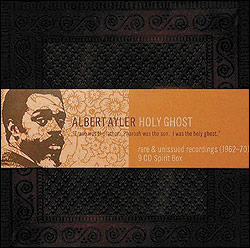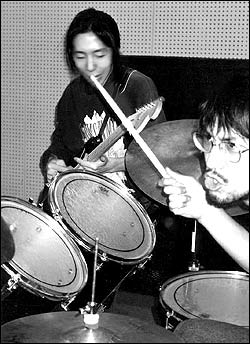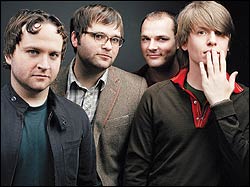TO MAKE A SOUND, you have to start from silencebut you can never actually hear silence. (Take every other sound away, as John Cage did in an anechoic chamber at MIT in the late ’40s, and you’ll hear a three-part arrangement: The bass is your circulatory system, the prickle of treble is your nervous system, the unshakable riff in the midrange is your breath.)
So the first deliberate sound that emerges from that background noise is the voice in isolation, talking to itself. As a writer, James Joyce made that voice, the one inside the head, the center of his work, but he only recorded 12 minutes and 41 seconds’ worth of the one from his throat. They’ve been collected on the honestly if misleadingly titled James Joyce: The Complete Recordings (Sub Rosa). The first of the disc’s two short pieces is an extract from the “Aeolus” episode of Ulysses, literally a voice talking to hear its own sound, a deliberately overblown piece of political rhetoric. It’s followed by maybe the most beautiful extant recording of an unaccompanied speaking voice, a 1929 reading of the “Anna Livia Plurabelle” section of Finnegans Wake. For eight minutes, a liquid-voiced Joyce impersonates the sound of the world talking to itself: Two washerwomen chat on the banks of a river as night falls, and they turn into a tree and a stone. His Irish accent, in fact, is so thick that it’s hard for an American, 75 years later, to hear the crackling recording as language, rather than as water and music. But that was the idea: Joyce told Arthur Power that the passage was “an attempt to subordinate words to the rhythm of water.”
Introduce fire and earth and air to primal near silence, though, and they’ll come toward each other, looking for something to latch onto, or to dance with. The saxophonist Pharoah Sanders built a string of extraordinary jazz records in the late ’60s and early ’70s around simple patterns sustained for a long time; for the first five or 10 minutes of each one, though, lonely atoms of saxophone and piano and percussion and bass would wander tentatively into each other’s gravitational fields. They’d gingerly enter into and spin out of orbit until, at last, they all aligned properly into the groove. Those initial, tender gropings from Sanders’ recordsand not their full-throated payoffsare the ancestors of His Name Is Alive‘s exquisite new Brown Rice (Time Stereo). HNIA first established itself as a dreamy pop band back in the late ’80s, but leader Warren Defever has spent the last decade moving the group away from modernity, in search of some kind of first principles of the pop song. For a while, that meant trying, literally, to write “Good Vibrations,” like Jorge Luis Borges’ Pierre Menard writing Cervantes’ Don Quixote from scratch; for a while, it meant retro-engineering his own and other bands’ songs to sound as if they’d been recorded on wax or wire. Defever has spent years obsessing over an old Carter Family song with even older roots, “I Can’t Feel at Home in This World Anymore.” (At a show in New York last month, HNIA played it twice.)
Brown Rice, all instrumental except for some mixed-in recordings of baby talk, is mostly chaos, but it’s chaos trying to organize itself. Celestial chimes and taps emerge from silence, cautiously trying to flow in the same direction; violins and saxophones eventually join them. A harp plays what could be the beginning of the Beach Boys’ “Wouldn’t It Be Nice,” scrambled beyond recognition; once or twice, Defever’s guitar can be heard paraphrasing “I Can’t Feel at Home in This World Anymore.”
THE ONLY REAL silence is the silence of a moment after it’s passed, and for the last hundred years or so, there’s been a way around that: recording. But you can’t record a sound or play it back without altering it irreparably. The machines that do the work refract what they capture and repeat. Joyce knew that, rocking toward and away from the microphone as he read “Anna Livia Plurabelle”; Defever knows that, reconstructing the parameters of the recordings he loves. And it’s the main point of Philip Jeck‘s work. The British artist’s music is built around the sound of recordings and their playersnot the performances stored on them, but the baseline noises of the material objects themselves. Often, bits of music stick to them, like shreds of meat on a bone.
Jeck’s new album, 7 (Touch), is a set of pieces made with old record players, vinyl, and a sampling keyboard. “Bush Hum,” for instance, has nothing to do with the White House: It’s the harmonic buzz of an old Bush record player, cranked up high and looped into a throbbing electric swarm. The album closes with “Veil”: a few notes that might once have been from strings or a piano but were definitely from a not-quite-immaculately recorded piece of vinyl, progressively stretched out on the sampler until their digital grain, or analog cracks, comes into sharp focus. Through those uncertainties and gaps, you can hear the blood and breath of recording, the failures of perfect reproduction that are its signs of life.
Smallmouth will appear every three weeks.








